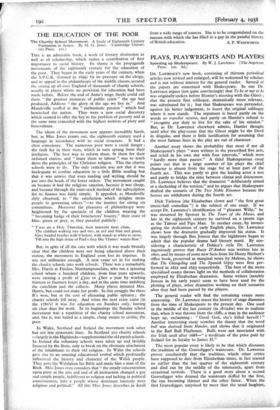PLAYS, PLAYWRIGHTS AND PLAYERS
DR. LAWRENCE'S new book, consisting of thirteen periodical articles now revised and enlarged, will be welcomed by scholars and is not without interest for the general reader. Several of the papers are concerned with Shakespeare. In one Dr. Lawrence argues (not quite convincingly) that To be or not to be was originally spoken before Hamlet's meeting with the Ghost ; that the present first soliloquy, dramatically more relevant, was substituted for it ; but that Shakespeare was persuaded, against his better judgement, to insert the original soliloquy where it now stands. The argument is based partly on the words no traveller returns, and partly on Hamlet's refusal to "recognise any duty to live for the sake of his mission." But, as Dr. Lawrence elsewhere admits, Hamlet thought until after the play-scene that the Ghost might be the Devil in disguise, and there is little justification for assuming that the most famous lines in the play are out of character.
Another essay shows the probability that most if not all Shakespeare's plays "were written in the prescribed five acts, and acted in his own day with four intervals," which were "hardly more than pauses." A third Shakespearean essay points out that in a large number of his plays the chief character is absent from the stage for at least part of the fourth act. This .was partly to give the leading actor a rest and partly to bridge the time between climax and denouement. Dr. Lawrence believes that the dramatist "deliberately aimed at a slackening of the tension," and he argues that Shakespeare drafted the scenario of The Two Noble Kinsmen because the heroes are withdrawn during the fourth act.
Dick Tarleton (the Elizabethan down and "the first great music-hall comedian ") is the subject of one essay. If we accept Dr. Lawrence's identification of "pleasant Willy," he was mourned by Spenser in The Tears of the Muses, and late in the eighteenth century he survived on a tavern sign as the Tabour and Pipe Man. In another essay, by investi- gating the dedications of early English plays, Dr. Lawrence shows how the dramatist gradually improved his status. It was largely through Ben Jonson that the highbrows began to admit that the popular drama had literary merit. By con- sidering a characteristic of Dekker's style Dr. Lawrence ingeniously proves that Bussy D'Ambois was written late in 1600, and by means of some new facts from Sir Henry Herbert's office book, preserved as marginal notes by Malone, he shows that The Changeling and The Spanish Gipsy were first per- formed in 1622 and 1623 respectively. The best of the more specialised essays throws light on the methods of collaboration employed by Elizabethan dramatists. Some writers (notably Jonson in his early years) seem to have been used for the plotting of plays, other dramatists working on their scenarios after they had been passed by the players.
The general reader will find the remaining essays more interesting. Dr. Lawrence traces the history of stage dummies from the time of Shakespeare to the present day. One used in the middle of the last century (in Ariadne) was so realistic that, when it was thrown from the cliffs, a man in the audience leapt up, exclaiming : "Good God, she's killed herself ! " Another interesting essay scotches the theory that the word bull was derived from blunder, and shows that it originated in the Red Bull Playhouse. Bulls were not associated with the Irish until after 1688—" a modicum of the price paid by Ireland for its loyalty to James II."
The most popular essay is likely to be that which discusses the tradition of the Gravedigger's waistcoats. Dr. Lawrence proves conclusively that the tradition, which other critics have supposed to date from Elizabethan times, in fact started no earlier than the last quarter of the eighteenth century and died out by the middle of the nineteenth, apart from occasional revivals. There is a good story about a second Gravedigger who donned the waistcoats doffed by the first, the one becoming thinner and the other fatter. When the first Gravedigger, surprised by more than the usual laughter, realised what was happening, he went back to his proper business of digging Ophelia's grave.
Dr. Lawrence's book is both entertaining and learned.. The one complaint to be made is that his style is sometimes marred by too much allusiveness and by phrases like " perennial appeal." Among the eight illustrations is an interesting















































 Previous page
Previous page